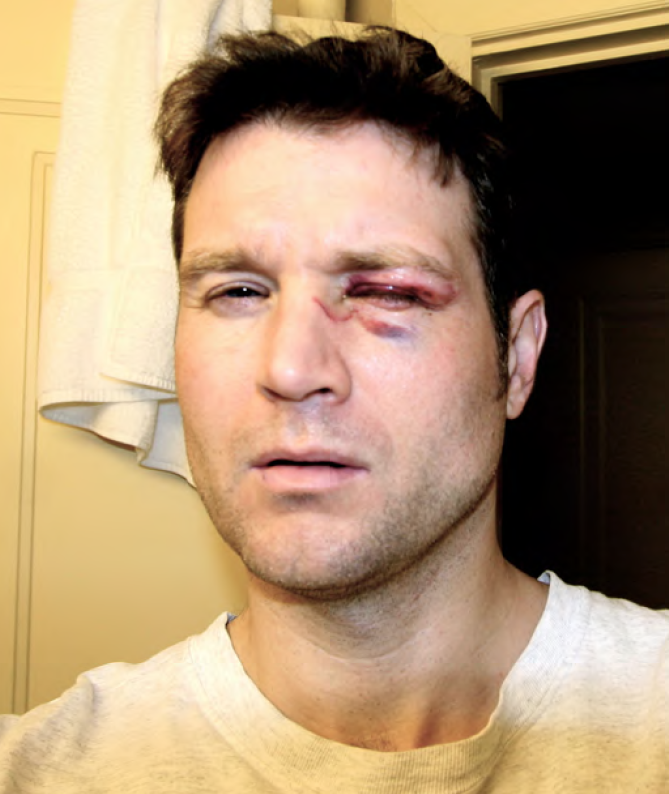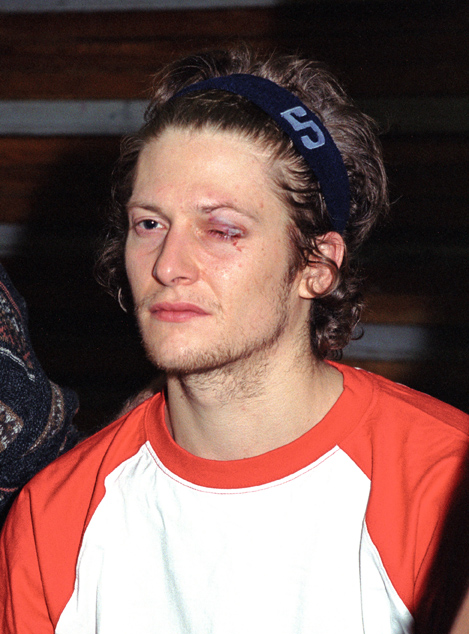
By James Zug
Photos by Steve Line/SquashPics.com
It happened in a challenge match. Jose and I were both seniors, the two captains of the team, battling it out on a dark, winter night in New Hampshire for the number-one spot on the varsity ladder of our college team. The match went to five and deep in the fifth game, at 12-all, I drove a forehand cross-court thatcame sharply off the side wall and then the back wall. Jose backed up and cranked a backhand rail. As he followed through, bam! I felt a stinging sensation on my face, then immediately my mouth went numb. I looked down: blood, a tooth on the floor. I wiped my mouth, pocketed the tooth and we continued. Jose won the next three points and the next morning I went to see a dentist.
I might have also been seeing an eye doctor, but this was November 1990 and so like all squash players in the U.S., I had been wearing eye goggles. They absorbed the part of the racquet that hit my eye.
You are going to get hit, by the ball or by the racquet, at some point. It is the nature of squash: the small court, the speeding ball, the jockeying for position. It happens in hardball, softball, singles and doubles. It happens among total duffers, the neophytes, the fumbling D players. It happens among the captains of a top-five college team. It happens to the editor of this magazine. It happens to US Squash board members: Emily Lungstrum got hit in the eye with a racquet playing doubles in the semis at the William Whit: doctors told her not to move her head for a week and no squash for months. “If I hadn’t been wearing goggles,” Lungstrum said, “the injury would have been devastating and I would have needed eye surgery.”
Eye doctors get hit. John Minkowski played at Princeton and in Baltimore in the 1980s, he won the state singles title. For a quarter of a century Minkowski has had a weekly game with a friend, Denny Bourke. In 1998, during his weekly game, his kids were on another court and one borrowed his goggles. Sure enough, Bourke mis-hit a ball and it slammed into Minkowski’s unprotected eye.
It happens among the pros. The standard argument given by PSA and WSA players for going goggle-free is that the very best never get hit, that they are so skilled and experienced that they know where each other are at all times (they also worry that goggles provide another time-wasting device). Top doubles players don’t use that argument because they know it is false. Two years ago at the William White, Alan Grant hit a return of serve straight into Doug Lifford’s face, causing a deep bruise. “It scabbed over and so I had a giant, squash-ball size spot on my face for a couple of weeks,” he said.
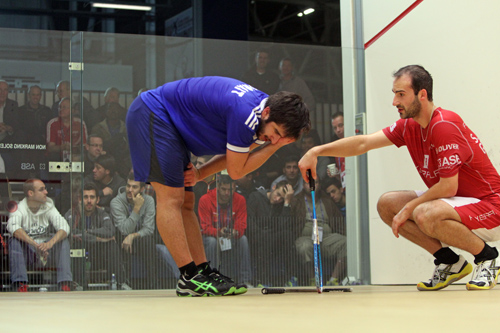
Lifford has been on the other side. In a pro doubles match in Boston a couple of years ago he cranked a ball into James Hewitt’s eye. Without goggles, Hewitt would have probably lost sight in his eye. “Liffy hit me with what he described as the hardest he could hit the ball,” Hewitt said. “He was about six feet away from me. He tried to go over my head but the ball went straight into my eye. I had no time to react. It broke the goggles, cut me for a dozen stitches along my eyebrow and also broke my orbital bone. I lost sight immediately and was rushed to the hospital with what they called an eight ball as my eye was completely full of blood. I was scheduled to get surgery as the pressure was mounting. First time I have ever had morphine, and I needed it, as I thought my head was going to explode. Fortunately before surgery they saw a tiny bit of draining in my eye and held off and in the end not getting the surgery. I spent a few extra days in Boston before it was deemed safe to fly. I then spent the following three weeks in bed as they were worried any pressure could damage the retina. I couldn’t play with the kids at all or even sneeze. After three weeks I slowly started getting back to doing things but my eye was super sensitive. The pupil was fully dilated for six months so any light caused me problems. It took a year before it was back to normal—although they weren’t sure if it would get back to normal. I was fortunate.”
But this is hardball. What about softball? In the semis of the 2002 World Open in Antwerp, David Palmer bashed Jonathon Power in the eye. Power had to retire from the match. In the semis of 2006 Motor City Open in Detroit, John White clipped Alex Gough in the eye on his backswing. Gough oozed blood. After the match, Gough said, “It’s a bit unfortunate to get smacked in the eye. It was just one of those things. It was a rally where we were both scurrying around and he just caught me on the back swing in the middle of the court.” In other words, nothing dramatic was occurring at the time of the incident. When I asked Gough about it, he shrugged it off: “It was just a clip—no need to see a doctor, no damage.”
Just last September at the Malaysian Open (also in the semis—why always the semis?) Borja Golan caught Peter Barker on the nose with a follow-through. It broke Barker’s nose. When you watch the replay, it is amazing because Golan’s swing is compact and not at all wild. Commonplace.
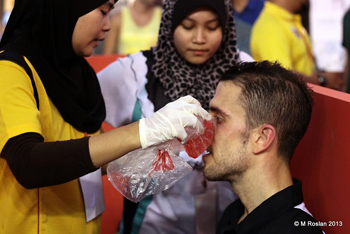
Paul Vinger, an ophthalmologist in Boston, has been researching eye injuries for more than thirty years. He has written more than thirty original papers on the subject and become the leading voice in America for setting standards in eye protection. The first thing he told me when I called him was: “If you play squash regularly, you have a one in four chance of getting hit in the eye.” This statistic comes from crunching of numbers that conclude that without eye protection, there is an eye injury for every 5,329 squash matches. If you play a match a week for fifty weeks a year for twenty-five years, you play about one-fourth of the 5,329. “Traumatic eye injuries are not accidents but predictable events,” Vinger wrote in a paper, after studying the literature from England, New Zealand, Germany and Australia, “almost boring in their regularity and predictability.”
Eye protection was first seriously mooted in the 1970s. “What happened in Toronto was I was seeing a new squash player every week with an injury,” said Michael Easterbrook, an ophthalmologist who has worked with the Toronto Maple Leafs and Raptors and who treated James Hewitt after his injury. In April 1980 Squash Ontario required players at the Ontario Junior Open to wear goggles. Three months later Squash Canada voted to make it mandatory for all junior events. “We did surveys in the late 1970s,” Easterbrook said, “and the clear result was better the player, the higher the risk of eye injury. The main reason was that good players actually follow the ball with their eye, they watch where it is going.”
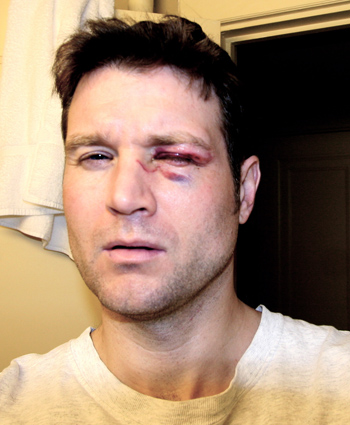
Herb Gross, the president of US Squash, pushed for America to follow Canada’s lead. “There wasn’t one specific trigger,” Gross said. “But there was the usual spate of eye injuries in the late 1970s that made this seem like an obvious thing to do. It became the most important issue of my presidency and I had quite a few of them.” A spate of eye injuries occurred around this time. Jon Bernheimer, at the time a twelve year-old junior, got hit twice in December 1980. While at Harvard, Mark Panarese got hit in the face. He dropped his racquet and rushed to the infirmary: broken nose. Went back for the racquet: gone. Not to be outdone, in 1980 Mark’s brother Matt got hit in the left eye while practicing at Penn and had to get many stitches. In Wilmington, Halsey Spruance (husband of Hall of Famer Gretchen Spruance) was playing a good friend. They played regularly and were familiar with each other’s game. This was probably the 100th time they had played. Spruance looked back and got hit by the ball. He spent three days in the hospital. At the 1981 Toledo Open, Tom Rumpler, the local pro, caught Hall of Famer Sharif Khan in the eye. Khan went out, got seven stitches and came back to win the match. “At the time & to this day, I felt absolutely terrible at having injured a player, my own personal hero, not to mention superstar,” Rumpler recently said. “That said, also at the time & to this day, I am certain that I did not take a bad swing. I have always been a “back-on” to the ball striker, in contrast to a “side-on” striker. My follow-through stops pretty much at the perpendicular to the front wall. The only explanation that I can offer as to why accidents such as that happen, is that sometimes when we get aggressive we play too close. It was a terrible moment for us both.”
Gross collaborated with Cynthia MacKay Keegan, a New York ophthalmologist and squash parent (Rob and Hope MacKay were top-ranked juniors in the 1980s). “I knew from patients how devastating eye injuries could be in squash,” Keegan said. “Robbie and Hope were wearing them and getting flak from kids. But I knew it was like playing Russian roulette—often there was no way to fix the eye after an injury.”
In March 1982 at Williams, Gross and Easterbrook made a presentation at the intercollegiate nationals at the annual dinner, and the next day the coaches voted in favor of requiring eye protection. Juniors soon followed suit. Easterbrook began going around the continent with an enormous twenty-panel exhibit, demonstrating the importance of the issue and various protective eyewear.
In the summer of 1982 Jack Herrick replaced Gross as president of US Squash and he too was passionate about eye protection. (He had been on the doubles court when his partner hit their opponent, Mike Schumann in the eye, causing Schumann to permanently be blind in that eye.) In the summer of 1983, US Squash took the big step and announced that all adults would have to wear eye protection in national events (in 1987 US Squash decreed that eye guards were required in all sanctioned events). One observer there wrote that Herrick had “pulled off one of squash’s most historic legislative coups” at the meeting, which he called “very stormy.”
Thus, beginning thirty years ago in February 1984, at the nationals in Cleveland, eye goggles became the norm. There was talk of boycotts as a number of players balked at wearing goggles in Cleveland. One was Scott Ryan, the president of the Philadelphia SRA. “I was against goggles in the early 80s,” Ryan said, “mainly because they would fog up and make it difficult to see clearly—back then, the hardball marked the walls so black that it was difficult to follow the ball, and fogging goggles made it worse. Being an independent cuss, I felt it was my decision whether or not to wear them, as it did not affect the other players, and if I was willing to accept the risk and sign a waiver, it should be my choice. To default someone because they chose to be stupid and exercise free will, it seemed too “big brother-ish” to me. I suspect it was also a little of the macho attitude similar to the hockey players who did not want to wear helmets when they were first introduced. I never said I was smart.” But under pressure, Ryan agreed to wear the goggles. He and another goggle reactionary, Kevan Pickens, ended up facing each other in the finals of the 35+, with Ryan winning in four.
Years later I ran into Ryan in the waiting room at the eye doctors—I had a retinal tear and was about to have surgery and Ryan next in line because he had a detached retina. (He sustained the injury probably from boxing at the Naval Academy.) He now has some vision out of the eye but it is distorted.
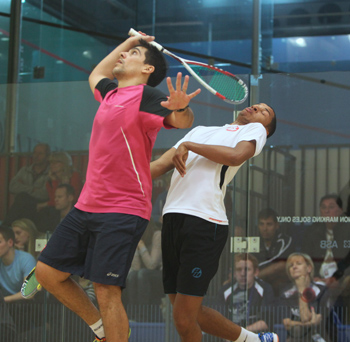
A key accelerator in the U.S.—and something decisively different from softball—is that the pros began to wear them. In 1986 the men’s tour, the WPSA, instituted a rule requiring eye protection, but grandfathering in any pro who joined the tour before then. Some began to wear them even if they weren’t required. The first player to wear them full-time was Mark Talbott. He started wearing goggles in the 1981-1982 season. Two years later Bausch & Lomb, makers of the industry leader Action Eyes goggles, began sponsoring Talbott. “It definitely turned some heads,” Talbott said. “Action Eyes was not the motivating factor, I just believed in it. The fact is over the years, all of the hundreds of matches I played, eye guards, I would guess, saved me at least six or seven times from potential serious injury.”
Some players went back and forth on wearing them—John Nimick won majors with them on and with them off—and some others tried to wiggle around—Pepe Martinez reacted to the mandate by wearing goggles, but just popping the lenses out. But in time, people fell into line. This was especially true in doubles. With four people out there, the chances of getting hit were higher, so by the late 1980s almost all pros wore eye goggles.
One of the effects of North America turning to softball was that the rest of the world took notice of the hardball mandates about eye protection. In October 1997 the World Squash Federation announced that it would require eye protection at WSF-sanctioned junior events beginning in January 1999.
Ever since the status quo has been that juniors outside North America wear eye goggles but once they become adults, they take them off. And then they get hurt.
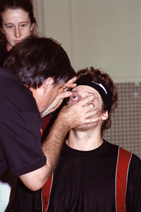 Many sports have evolved how they treat protective equipment. In 2005 US Lacrosse required all women players to wear protective eyewear; however, much like in squash, other nations haven’t followed suit and international matches are usually eye-goggle free. The NHL mandated just last summer that helmet visors are required for all players with twenty-five games experience or less, thus grandfathering in eye protection (three-quarters of NHL players already wear a visor). But Easterbrook noted that eye injuries still occur with visors, as sticks can slip up underneath; he knows of nine cases where a hockey player wearing a visor is now blind in one eye. High school field hockey has also instituted eye protection recently.
Many sports have evolved how they treat protective equipment. In 2005 US Lacrosse required all women players to wear protective eyewear; however, much like in squash, other nations haven’t followed suit and international matches are usually eye-goggle free. The NHL mandated just last summer that helmet visors are required for all players with twenty-five games experience or less, thus grandfathering in eye protection (three-quarters of NHL players already wear a visor). But Easterbrook noted that eye injuries still occur with visors, as sticks can slip up underneath; he knows of nine cases where a hockey player wearing a visor is now blind in one eye. High school field hockey has also instituted eye protection recently.
Thirty years after the first tournaments requiring eyewear, US Squash remains at the vanguard of eye protection. Beginning in January 2014, all members of US Squash’s Elite Athlete Program have to wear goggles at all times. Making sure goggles are actually protective, in 2013 US Squash joined the American Society for Testing and Materials and shifted from accepting manufacturer’s declarations of conformity to third-party assessments to make sure the goggles are doing what they are supposed to be doing. “I’ve never seen a blind eye result from wearing the proper eye protection in squash,” Easterbrook said. “Developing and testing the standards for that protection have been key.”
Kevin Klipstein, the CEO of US Squash, serves on the F08 committee at ASTM that covers standards, regulatory, compliance and third-party testing designations for sports. “I feel eye protection reflects a core value of squash,” Klipstein said. “We believe that squash is a lifetime sport. Why cut that short by sustaining a preventable injury?”


